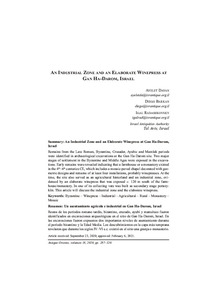Please use this identifier to cite or link to this item:
https://repositorio.uca.edu.ar/handle/123456789/11717| Título: | An industrial zone and an elaborate winepress at Gan Ha-Darom, Israel Un asentamiento agrícola e industrial en Gan Ha-Darom, Israel |
Autor: | Dayan, Ayelet Barkan, Diego Radashkovsky, Igal |
Palabras clave: | BIZANCIO; IMPERIO ROMANO; EXCAVACIONES ARQUEOLOGICAS; EXPLOTACIONES AGRARIAS; HISTORIA CULTURAL | Fecha de publicación: | 2020 | Editorial: | Pontificia Universidad Católica Argentina. Facultad de Ciencias Sociales. Departamento de Historia. Centro de Estudios de Historia del Antiguo Oriente | Cita: | Dayan, A., Barkan, D., Radashkovsky, I. An industrial zone and an elaborate winepress at Gan Ha-Darom, Israel [en línea]. Antiguo Oriente. 2020, 18. Disponible en: https://repositorio.uca.edu.ar/handle/123456789/11717 | Resumen: | Abstract: Remains from the Late Roman, Byzantine, Crusader, Ayubic and Mamluk periods
were identified in archaeological excavations at the Gan Ha-Darom site. Two major
stages of settlement in the Byzantine and Middle Ages were exposed in the excavations.
Early remains were revealed indicating that a farmhouse or a monastery existed
in the 4th–6th centuries CE, which includes a mosaic-paved chapel decorated with geometric
designs and remains of at least four installations, probably winepresses. At the
time, the site also served as an agricultural hinterland and an industrial zone, evidenced
by an elaborate winepress that was exposed c. 120 m south of the farmhouse/
monastery. In one of its collecting vats was built as secondary stage potterykiln.
This article will discuss the industrial zone and the elaborate winepress. Resumen: Restos de los períodos romano tardío, bizantino, cruzado, ayubí y mameluco fueron identificados en excavaciones arqueológicas en el sitio de Gan Ha-Darom, Israel. En las excavaciones fueron expuestos dos importantes niveles de asentamiento durante el período bizantino y la Edad Media. Los descubrimientos en la capa más temprana revelaron que durante los siglos IV–VI e.c. existió en el sitio una granja o monasterio. Los restos incluyen una capilla pavimentada con mosaicos decorados con diseños geométricos así como restos de al menos cuatro instalaciones, probablemente lagares (prensas de vino). Durante ese período, el funcionamiento del sitio estuvo ligado con explotaciones agrarias e industriales, evidenciadas por otro sofisticado lagar que fue expuesto ca. 120 m al sur de la granja/monasterio. En una etapa secundaria en uno de sus pozos colectores se construyó un horno de alfarería. Este artículo tratará sobre dicha zona industrial y el elaborado lagar. |
URI: | https://repositorio.uca.edu.ar/handle/123456789/11717 | ISSN: | 1667-9202 | Disciplina: | HISTORIA | Derechos: | Acceso abierto | Fuente: | Antiguo Oriente. 2020, 18 |
| Appears in Collections: | AO - 2020 vol. 18 |
Files in This Item:
| File | Description | Size | Format | |
|---|---|---|---|---|
| industrial-zone-elaborate-winepress.pdf | 2,89 MB | Adobe PDF |  View/Open |
Page view(s)
112
checked on Apr 30, 2024
Download(s)
133
checked on Apr 30, 2024
Google ScholarTM
Check
This item is licensed under a Creative Commons License

